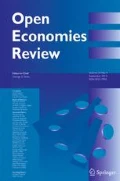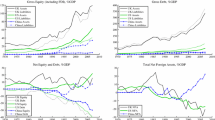Abstract
Panel analysis of 21 industrial countries shows evidence for pro-cyclicality of capital gains on domestic stock markets over a medium term horizon. Thus, with cross-border ownership of portfolio equity investments, potential for hedging against domestic output fluctuations by means of the capital gains channel of foreign liabilities is found. Individual country analysis reveals substantial heterogeneity of cyclicality patterns. Evidence suggests that this cross-country variation can be explained by the level of economic development and the size of financial markets.
Similar content being viewed by others
Notes
See Lane and Milesi-Ferretti (2007) for a documentation of the rapid growth in cross-border financial holdings.
See Table 3 in the Web Appendix for a country analysis of rates of capital gains on foreign liabilities using international investment positions data. For portfolio investments, these are usually very similar to market rates, but often less accurate and poorer in terms of data availability—see Lane and Milesi-Ferretti (2008a).
The realisation of capital gains and losses involves liquidation costs however, which increase with the extent of illiquidity. This applies to FDI in particular, but less to portfolio investments.
Capital gains on foreign assets, on the other hand, are influenced by a broad range of global factors such that a satisfying analysis is beyond the scope of this paper.
This two-step approach is adapted from Lane’s (2003) cyclicality analysis on fiscal policy.
If firms choose not to pay out dividends, but instead to keep retained earnings, the mechanism works as well, since this should be reflected in higher stock prices and thus capital gains.
See their paper for a model of international trade in risky financial assets under incomplete markets.
Australia, Austria, Belgium, Canada, Denmark, Finland, France, Germany, Greece, Ireland, Italy, Japan, the Netherlands, New Zealand, Norway, Portugal, Spain, Sweden, Switzerland, the United Kingdom and the United States.
Data availability differs by country. See Appendix for an overview.
If β is < 0, thus counter-cyclical, risk sharing would be in theory possible if foreign investors take short positions in the domestic markets. However, this possibility is not very feasible on a large scale on current financial markets.
We use average values by country for the explanatory variables over the period from 1975 to 2006 (until 2004 for GDP per capita), including only those years where actual rates of capital gains were available.
We weight by the (in the previous step) obtained t-statistics.
In the main tables of the country-by-country analysis we focus on reporting the estimated β-coefficients and associated standard errors in order to present the key results as clear and concise as possible. More diagnostic statistics are provided in Table 1 and Table 2 of the Web Appendix.
Using quarterly total returns data from 1970 to 1991.
For 22 countries from 1970 to 1995.
The significant negative βs obtained by estimation 4 for Belgium, Denmark, United Kingdom and the United States could theoretically imply the potential to share idiosyncratic macroeconomic risk by short positions of foreign investors.
We drop Switzerland from the heterogeneity analysis of stock markets, as it represents an outlier in terms of its average stock market capitalisation.
References
Alesina A, Campante F, Tabellini G (2007) Why is fiscal policy often procyclical? Mimeo, Harvard University
Backus D, Kehoe P, Kydland F (1995) International cycles: theory and evidence. In: Cooley T (ed) Frontiers of business cycle research. Princeton University Press, Princeton, pp 331–356
Canova F, de Nicolo’ G (1995) Stock returns and real activity: a structural approach. Eur Econ Rev 39:981–1015
Chen N-F, Roll R, Ross SA (1986) Economic forces and the stock market. J Bus 59(3):383–403
Davis S, Nalewaik J, Willen P (2001) On the gains to international trade in risky financial assets. Mimeo, Chicago Graduate School of Business
Devereux MB, Sutherland A (2007) Country portfolio dynamics. Mimeo, University of British Columbia
Faria A, Lane PR, Mauro P, Milesi-Ferretti GM (2007) The shifting composition of external liabilities. J Eur Econ Assoc 5(2–3):480–490, April/May
Forbes K, Rigobon R (1998) No contagion, only interdependence: measuring stock market co-movements. NBER Working Paper No 7267
Giannone D, Reichlin L (2006) Trends and cycles in the Euro area: how much heterogeneity and should we worry about it? ECB Working Paper No 595
Lane PR (2001) Do international investment income flows smooth consumption? Weltwirtsch Arch 137:263–94
Lane PR (2003) The cyclical behaviour of fiscal policy: evidence from the OECD. J Public Econ 87:2661–2675
Lane PR, Milesi-Ferretti GM (2007) The external wealth of nations mark II: revised and extended estimates of foreign assets and liabilities, 1970–2004. J Int Econ 73(2):223–250
Lane PR, Milesi-Ferretti GM (2008a) Where did all the borrowing go? A forensic analysis of the U.S. external position, IIIS Discussion Paper No. 239
Lane PR, Milesi-Ferretti GM (2008b) International investment patterns. Rev Econ Stat 90(3):538–549, August
Lewis K (1996) What can explain the apparent lack of international consumption risk-sharing? J Polit Econ 104:267–267
Liew J, Vassalou M (2000) Can book-to-market, size and momentum be risk factors that predict economic growth? J Financ Econ 57(2):221–245
Merton RC (1990) The financial system and economic performance. J Financ Serv Res 4(4):263–300
Obstfeld M (2004) External adjustment. Rev World Econ 140:541–568
Obstfeld M (2006) International risk-sharing and the costs of trade. The Ohlin Lectures, Stockholm, November
Shiller RJ (1993) Macro markets: creating institutions for managing society’s largest economic risks. Oxford University Press, Clarendon Series, Oxford
Sørensen B, Wu L, Yosha O (2001) Output fluctuations and fiscal policy: US state and local governments 1978–1994. Eur Econ Rev 45:1271–1310
Sørensen B, Wu Y-T, Yosha O, Zhu Y (2007) Home bias and international risk sharing: twin puzzles seperated at birth. J Int Money Financ 26(4):587–605
Tille C, van Wincoop E (2007) International capital flows. NBER Working Paper No 12568
Author information
Authors and Affiliations
Additional information
I am grateful to Philip Lane for his encouragement and very helpful comments. I am also thankful for comments and discussions to two anonymous referees, Thierry Bracke, Christiane Hellmanzik, Nils Holinski and Sébastien Wälti. Seminar participants at the International Macro Group and the Graduate Seminars at Trinity College Dublin and at the Jean-Monnet Workshop “Financial Market Integration, Structural Change, Foreign Direct Investment and Economic Growth in the EU-25” in Brussels, April 2008, provided insightful feedback. The author gratefully acknowledges the financial support of the Irish Research Council for the Humanities and Social Sciences (IRCHSS) and the IIIS.
Electronic supplementary material
Below is the link to the electronic supplementary material.
Appendix
Appendix
Rights and permissions
About this article
Cite this article
Schmitz, M. Financial Markets and International Risk Sharing. Open Econ Rev 21, 413–431 (2010). https://doi.org/10.1007/s11079-008-9100-x
Published:
Issue Date:
DOI: https://doi.org/10.1007/s11079-008-9100-x




